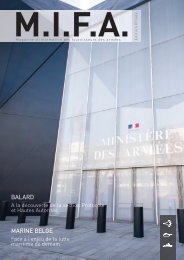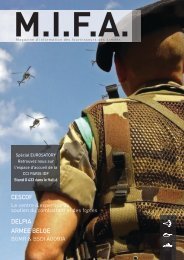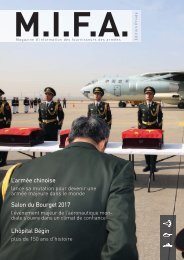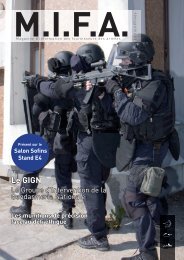FED 2019 - MIFAMAG
You also want an ePaper? Increase the reach of your titles
YUMPU automatically turns print PDFs into web optimized ePapers that Google loves.
092<br />
The budget allocated to the Army is a recurrent issue.<br />
How does the SIMMT optimise its means in the<br />
face of budgetary constraints without jeopardising<br />
ground operations?<br />
First of all, we must specify that the military programming<br />
law <strong>2019</strong>-2025 fully recognises the need<br />
to maintain the equipment linked to the rise of the<br />
operational preparation of the activity of the forces.<br />
The resources for the programmed maintenance of<br />
equipment are on the up for this period.<br />
Obviously, the SIMMT is in Order of Battle and enjoys<br />
the tools to optimise the use of resources entrusted<br />
by the army staff and other contractors. The<br />
SIMMT relies on an overall performance resting on<br />
the search for efficiency in every sector where this<br />
is possible. In a first while, the integrated organisation<br />
of the SIMMT is a key factor of the MCO-T’s global<br />
performance. From the definition of support and<br />
contracting to until the liquidation of expenditure, it<br />
allows optimizing the physical-budgetary room for<br />
manoeuvre and to establish an essential physical-financial<br />
link between the allocated resource and expected<br />
production.<br />
Moreover, we are reinforcing this physical and financial<br />
link by developing genuine economic models for<br />
each of the main equipment parks to identify spending<br />
for the right need, depending on the available<br />
state and private production means.<br />
mament programmes and that are most often acquired<br />
by the means of purchasing platforms and “on<br />
the shelf”. We are summoned by the various armies,<br />
directorates and departments for all ground equipment,<br />
mostly for little or non-militarised vehicles,<br />
small calibre weapons, or still, optical devices.<br />
You say that equipment maintenance is an act of<br />
combat. But maintenance can seem like a less attractive<br />
function for the public or popular media,<br />
unlike other more “warrior” operational function. Is<br />
this the case?<br />
For the past ten years, there has been a rise in the<br />
awareness of our sturdier engagements, yesterday<br />
in Afghanistan, today in the Sahel-Saharan region.<br />
All our operations are carried out in a Joint Warfare<br />
or joint framework, where everyone realises the interest<br />
and contribution of adjacent operational functions.<br />
They are all complementary. Each weapon<br />
has its specificities and attracts a different public.<br />
Although less mediatised than other operational<br />
functions that lead operations, everybody know and<br />
considers maintenance as an essential function on<br />
the ground. The Equipment section does however<br />
recruit its staff from another pool. Moreover, we are<br />
developing new partnerships with the national department<br />
of education, particularly vocational colleges,<br />
to draw the best young people into our ranks.<br />
093<br />
Finally, since the last 10 years, the SIMMT develops<br />
and implements global contracts that we call Markets<br />
for Support in Service (MSS) and that interest<br />
the industrials in terms of performance: the support<br />
of the Leclerc tank is a precursor in this area.<br />
You spoke of “warrior” operational functions. In actual<br />
fact, the warrior spirit irrigates the entire army,<br />
regardless of weaponry, as it combines discipline,<br />
technology and tradition, which are qualities that can<br />
be found in all our units.<br />
M.I.F.A. - <strong>FED</strong> <strong>2019</strong><br />
Does the SIMMT enjoy close contacts with the DGA<br />
to prepare for the arrival of new equipment and to<br />
anticipate the resultant maintenance?<br />
The Directorate General of Armaments is an indispensable<br />
support for the SIMMT in the elaboration<br />
of the support strategies for new equipment. The arrival<br />
of new equipment is steered by integrated programme<br />
teams with which the SIMMT participates<br />
hand-in-hand, along with the DGA and the Technical<br />
Section of the Army. The maintenance problematic<br />
is considered as soon as possible so that the future<br />
equipment can be as efficiently supported from their<br />
first day of use and in time.<br />
Is the SIMMT likely to purchase other equipment in<br />
complement of the DGA. What type of equipment?<br />
What is its purpose?<br />
Indeed, without being an organ for the acquisition<br />
of capacity, the SIMMT acquires equipment for the<br />
forces. This equipment complements the major ar-<br />
My General, during our interview you broached several<br />
concrete concepts and subjects. Could you summarise<br />
them in just one word?<br />
Modern. I believe that the MCO-T is a resolutely modern<br />
domain, both in the techniques and processes<br />
and in the state of mind. All the areas relating to the<br />
MCO-T are becoming increasingly complex and modern.<br />
In the face of this modernisation, the MCO-T<br />
adapts to its environment. This adaptation is more<br />
essential still that the expectations from the armed<br />
forces are constantly growing. The challenge is<br />
considerable, but the men and women of the MCO-T<br />
seem ready to take it up. Every day, they see the fruit<br />
of their work. The progresses made these past two<br />
years in terms of the availability of the equipment<br />
motivate us to relentlessly continue the construction<br />
of tomorrow’s maintenance. I’m confident!<br />
Marie-Madeleine COURTIAL<br />
M.I.F.A. - <strong>FED</strong> <strong>2019</strong>















